See Temples in Myanmar in 2013
Part 1
(Travel Story Series @ Hon Too Fang 2021)
(Note in 2021: the original story is in the email format)
**************************************
My friends,
In January 2013 we went on a 12-day group tour to Myanmar. This is the story, might not be so interesting though. Hope you will be a little bit more educated about this Asean neighbour of ours after reading the story.
This is no April Fool joke.
Hon
(01-4-2013)
**************************************
1 -- Why Myanmar
Why go Myanmar? There is a story. The old name of Myanmar as used by the British colonial masters was Burma. One day in 2012, our 6-month-old granddaughter came to visit. This cutie has little hair, so the Hokkien grandma seated her in her lap and was teasing her with, "bo moh, bo moh". "Bo moh" means no hair in Hokkien. At the exact moment my friend Peter called and heard the teasing words. Either Peter's hearing was not good, or his latest i-Phone was of low fidelity, he heard it was "Burma" and said, "Going to Burma eh?"
Mmmm, why not? So to Myanmar we went.
2 – Myanmar, an introduction
Myanmar is about twice the size of Malaysia and 5 times the size of Peninsular Malaysia. A big place to explore. It has some 53 million people, about twice that of Malaysia. The fertility rate is about 2.3, a very low figure for a developing nation. The main population centres are located around the Ayeyarwady Valley and the Delta, as well as the highlands occupied by the minority ethnic tribes.
Administratively the country is divided into 7 regions and 7 states. The regions are mostly occupied by the dominant race, the Bamars, while the states are occupied by the minority ethnic tribes. The biggest city and the commercial centre is Yangon with some 4.3 million people and the capital is Naypyidaw, a new city specifically constructed in 2006 to be the capital.
The country started its civilisation in the 2nd century. Minor kingdoms started to emerge, including the Pyu city-states in Upper Burma and the Mons in Lower Burma. In the 9th century the Bamar people came up from the Ayeyarwady River and became the dominant race from the 11th century onwards. The first kingdom was founded in Bagan in the mid-11th century unifying the city states in the Ayeyarwady Valley.
It was colonized by the British, in various stages, in the 1800s. It gained independence in 1948. After independence it was mostly ruled by the military government for long periods. It is now a republic with an elected parliament of 2 houses. The influence of the military remains powerful though. The central government has long running problems with the minority ethnic groups.
In economy, agriculture still dominates. The per capita GDP for 2013 is estimated as around US$ 1,150, or about 11% of Malaysia (US$ 10,800). Its natural resources include oil and natural gas. The service industry, mainly tourism, is picking up. But one thing it produces is World famous: precious stones like jade and rubies and sapphires.
Now you know why my wife also came on this tour.
3 -- People of Myanmar
About 68% of the people are the Bamars but there are many recognised minority tribes, like Shan (9%), Karen (7%), and Rakhine (4%). Most of the bigger minority tribes live in the states named after them, e.g. most Shans live in the State of Shan in the north-east. Religion wise, most are Buddhists (about 89%), the Theravada branch, but the Karens are mostly Christians and the Rohinyas (in the State of Rakhine in the west) are Muslims.
Women of the minority tribes wear different types of headgear unique to their custom and culture. Recognise any?
The prominent lady in this country is of course Aung San Suu Kyi. Some say she is Hainanese, “su ki nang”!
4 -- Languages of Myanmar
The official language is Burmese, originally used by the majority tribe, the Bamars. The Burmese scripts consists of mostly circles and rings. Very difficult to learn for we seniors. We couldn't even read the registration number of our tour bus. But they do offer good calligraphic practice. The 2nd photo shows safe deposit boxes outside a temple, not to keep your US$, but for shoes. Visitors to temples must be bare footed. The photo shows the numbers in sequence in the Burmese script.
5 -- The flower girls
One thing truly unique in Myanmar is the application of this powder made from the bark of the thanaka tree on the cheeks of the Burmese women, young and old. Some men and boys use it too. This yellow-whitish cosmetic cream has been used for 2,000 years. The merits include a cooling sensation, protection from sunburn, promote smooth skin, and it is mildly fragrant. Supposed to be anti-fungal too. Could challenge your RM 180 a bottle Estee Lauder for sure. The common method of application is to make some simple pattern on the cheeks.
Look at the patterns on the 2 girls below. The first one a flower girl, selling fresh flowers at a temple site. The second one sells the "flowers" on her cheeks. Had to tip her lah after taking her photo, for such time-consuming job to create the beautiful face.
6 -- Theravada Buddhism and the monks
Theravada Buddhism is the oldest of several branches of Buddhism, popular in Sri Lanka and South-east Asia. 99% of the Burmese follow this branch. In Sanskrit it means "the Way of the Elders". The other main branch is Mahayana Buddhism, popular in China, Korea and Japan. In Theravada Buddhism, only Buddha counts. In Mahayana Buddhism there is this concept of Bodhisattvahood, the Bodhisattva is the enlightened being just before reaching Buddhahood, the most celebrated Bodhisattva in China is Guan Yin 观音菩萨. So we won't see images of Bodhisattvas in temples in Myanmar, except may be in Chinatown.
Now a few words about Buddhist structures.
“Stupas” are generally solid, bell-shaped structures that contain a holy relic such as a hair or tooth from Buddha, relics or remains of other eminent Buddhist figure, or a sacred Buddhist scripture. They are modelled on ancient Indian burial mounds. Typically it has a many-stepped square base, above which is the dome, usually with a square reliquary chamber inside, then an upper spire with umbrella wheels, and other crowning decorations.
A Buddhist temple is a place of worship, generally contains an image of Buddha. They come in many shapes and sizes, with a cluster of buildings.
Shown stupa fields in the State of Shan and in Mandalay.
In Theravada Buddhism, leading a monastic life is considered a superior method to achieve nirvana. So most ordinary lay man will choose to become temporary "monks" for short periods in their lives, usually once before reaching adulthood and once after that. Some women too.
The monk eats only one meal a day. Think about that for a growing teenager. Only a meal a day, a growing boy! That is a real sacrifice.
Shown many monks walking on the street in Yangon on their morning “alms-receiving” round, 3 praying monks, 2 worrying monks and 1 studying monk. Plus a walking nun.
7 -- Buddha-image making industry
With every temple and shrine and home and office and departmental store and street corner displaying images of Buddha, the making of Buddha statues is an industry. We visited one such factory: showing an unfinished terracotta Buddha (still under enlightenment), a polished (fully enlightened) wooden one and a nearly-enlightened bronze Jet Li 李连杰 lookalike.
8 -- In Gold we trust
In Myanmar many Buddha statues are gilded or pasted with super-thin gold leaves. One of the most heavily gold-decorated Buddha statues is the 3.8-meter high seated Buddha at the Mahamuni Paya in Mandalay. The pure gold cover layer on the body is now 15 cm thick, according to Lonely Planet. The Buddha is seriously over-weight. Shown this Buddha image, and pilgrims sticking gold leaves onto another famous Buddha image, that at the Phang Daw Oo Paya at Lake Inle.
Then the fully gilded giant stupa of Shwezigon Paya in Bagan, together with the guarding lion in camouflage. See the lion? Even the coconut offering is coated with gold paint. In English "god" and "gold" are nearly the same, not sure how "god" and "gold" are related in the Burmese script.
9 -- In Spirit we also trust
Most Burmese believe in the teaching of the Buddha. In practical life, they also pray to some specific spirits for specific needs. These spirits are called "nats". The most famous nat shrine is located at Mt Popa in central Myanmar. There are 37 "official" nats worshiped there, including one for gamblers. The 37 were “sanctioned” by a Bagan king in the 11th century. Prior to that, there were many more nats. The nat could be an historical figure, usually a royalty or the religious. Not unlike the patron saints of the Catholics and Orthodox Christians. Shown some of the nat statues on Mt Popa. And being in the practical World, offering the spirits with money is practical. There is a RM 10 note stuck to the nat in the 2nd photo. RM from our group? Is he the nat for 4D?
10 -- Some traditional industries
We visited various workshops and factories of their traditional industries, outlets set up for the tourists, like weaving, silver works, lacquer ware, tobacco, etc. The one worth mentioning is the making of palm spirit, like our coconut toddy. Shown a worker demonstrating the harvesting of palm sap (see the worker?) and the brewing of the silvery spirit. And also the making of some dark soya paste. This one a real production house, in a dirty place, not a tourists’ show. And buffaloes are still being used for grinding grains in the rural areas.
11 -- Tough living for the Burmese
The per capital GDP is only US$ 1,150 a year. A waitress in Bagan probably earns around RM 150 a month. It is a tough life out there. No work because of no FDI. No FDI because the corrupt and authoritarian military is effectively ruling the country, despite an elected government. See how a government determines the lives of its people.
Shown some unusual jobs: "arthritis-inducingly" wading in waist-deep water in the Ayeyarwady River to sell a bunch of bananas, "brain-damagingly" carrying the whole supermarket on her head, "back-breakingly" transporting tobacco leaves and "sun-stroke inducingly" washing laundry under the mid-day sun.
12 -- Local wet markets
Visited a few of their local markets in the rural areas. Nothing special, except the sale of field rats as food and the funny way to cut open a fish to be dried and sold.
13 -- Shopping and souvenirs
Many members bought the Burmese sarong called longyi. Shown some craft items: puppets, coconut monkeys and the latest branded LV 4-in-1.
14 -- Sunsets in Myanmar
We were led to view sunsets 3 times on this trip. I don't understand what is so special about sunsets in Myanmar. The sun in Malaysia don't set meh? Shown a sunset view, shot from the upper tier of the Shwesandaw Paya in Bagan, and some other photographers on their premium seats.
*******************
Now we go sight seeing, with a simple map to show the relative locations of the major sights to be visited.
On this tour we went to the main city of Yangon, the central region of Mandalay and Bagan, and further east to Lake Inle. In between we stopped/stayed at smaller towns like Amarapura, Inwa, Kalaw, Mt Popa, etc.
15 -- Yangon - the Shwedagon Paya
This is the largest and most important Buddhist temple in Myanmar. The main stupa is 99 m high, mostly solid, standing over a platform 12 acres in size, surrounded by many smaller stupas, shrines, pavilions and images. It was first constructed before the 10th centuries. The present layout dates back to 1769. Shown the main stupa, shrines, pavilions, etc, devotees praying in halls with Buddha images, and washing a Buddha image (6th photo). Simply magnificent.
16 -- Yangon - Chaukhtatgyi Paya
A small temple with a giant reclining Buddha, 72 m long. The most unusual feature is the 108 glass mosaic marks on his soles, said to be related to his reincarnation in the 3 worlds before reaching Buddhahood.
17 -- Yangon - Sule Paya
This temple, right in the town centre, is said to be the oldest Buddhist temple in town. Politically the location is significant. It was the rallying point for several historic events. Shown a Buddha image in the unusual green colour and some decorative elements found in the temple.
18 -- Yangon - other sights
Yangon has a small but vibrant China Town, right in the town centre. There are many goldsmith shops. The temple of Guanyin观音古庙 was founded in 1823 by the Cantonese.
Being a former British colony, one can expect churches in the capital. There are a few, both Anglican and Catholic churches. Shown the Holy Trinity Anglican Cathedral and the St Mary Catholic Cathedral.
19 -- Mandalay – Mahamuni Paya
Mandalay is the main city and economic hub in Upper Myanmar, population about 1.4 millions. It was a former capital in the mid-1800s. It became famous because in 1890, Rudyard Kipling wrote a poem named "Mandalay" and the phases were later adopted in a song called "Road to Mandalay". The main tourist attractions include the Old Palace and several temples. The most important temple is the Mahamuni Paya where the Buddha statue is considered a "living image". There is a morning ritual of the "washing" of the face of the Buddha. Shown the Old Palace walls, and the Mahamuni Paya in the morning.
20 -- Mandalay - more temples
Then we have the Kuthodaw Paya. Each of these 729 stupas houses a stone slab inscribed with Buddhist scriptures. The whole place is known as the World's Biggest Book.
Lastly 2 temples built with teak and both in traditional Burmese architecture. The Shwe in Bin Kyaung and the Shwenandaw Kyaung with carvings on the life story of the Buddha.
21 -- Amarapura – monastery
About 12 km south of Mandalay city is this monastery of Maha Ganayon Kyaung where tourists flock here to see the young monks and nuns receive their meal at 11 am, supposedly the single meal for the day.
Further south is the township of Amarapura, an old capital, where we find the U Bein bridge. At 1.2 km this is the oldest and longest foot bridge in the World built with teak wood. It spans over a lake and was built around 1850. A good spot for photo shoot for newly-weds.
22 -- Inwa – the ruins
Inwa, a small town in the Mandalay region, was a former capital of the Burmese kingdoms for 360 years from 1365 to 1842. We had a morning tour of the old ruins in the 2-seater
1-horsepower Ferrari. Shown the 28-m high "Leaning Tower of Nabmyin", constructed in 1822 and tilted after a major earthquake in 1838. And some “photogenic” ruins, one with giant teak posts in the 4th photo.

To be continued.............................
















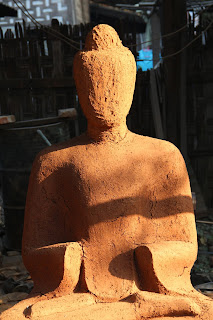






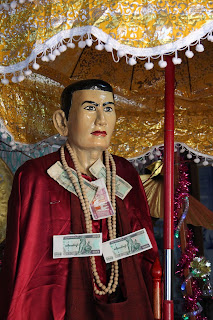
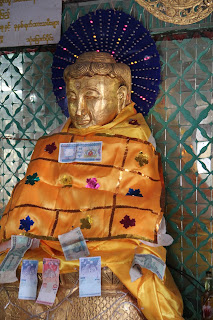

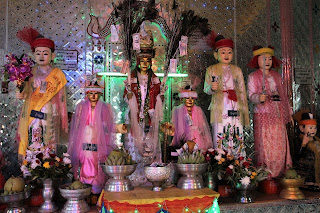



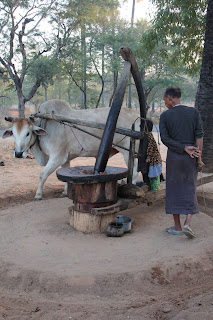


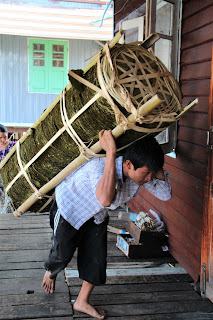










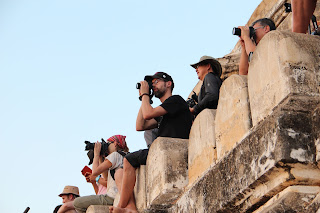






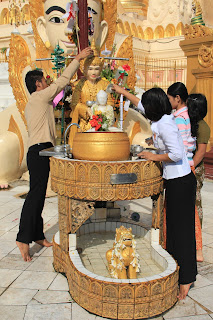








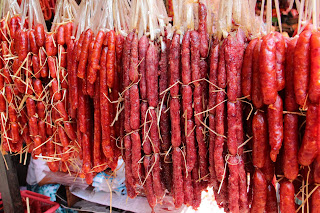






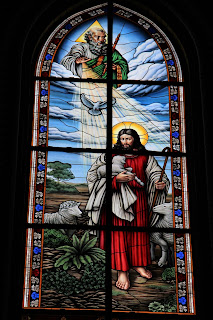







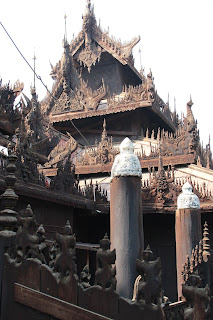













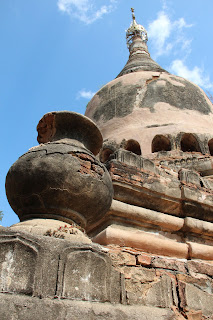
No comments:
Post a Comment